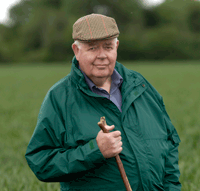David Richardson: What we need is stability

The challenges Sir John Beddington set out as priorities in his recent Foresight Report into world food security included balancing future demand and supply sustainably; ensuring adequate stability in food supplies; achieving global access to food and ending hunger; mitigating climate change; and maintaining biodiversity while feeding the world.
I agree. I came to almost identical conclusions in a paper (summarised in Farmers Weekly) on the same subject more than three years ago.
All that’s happened in the interim is that the problems have become more acute and decisive action to deal with them more urgent. Meanwhile, the world is in a financial crisis, which will cause even more delays.
The fact that here in the West, supermarket shelves are still fully stocked, even though prices are higher, allows the luxury of inaction.
But as I suggested in my paper and the Foresight Report confirmed, it may already be too late to initiate the research and innovative systems that could avoid further hunger, food riots and possibly worse.
Crop yields, milk production and the like cannot be increased exponentially overnight. “Just in time” doesn’t apply with biology. It takes years and it takes investment. It also requires a stable trading environment in which farmers can work with confidence that their production will earn a viable return. Volatility is not a recipe for stable production or steady food prices.
But that is exactly what we have at present. According to DEFRA’s Farm Business Income forecasts, published last month, dairy farmers can expect a drop of 24% in their incomes during the trading year 2010-11. Grazing livestock farmers in less favoured areas will see their incomes decrease by 33%, with lowland graziers down by 48%.
Poultry farms could see a fall of 6% year-on-year, but be down 50% compared with 2007-08. Pig farmers face a drop of 66% because of higher feed costs and lower prices.
Cereal farmers, on the other hand, could be 73% better off in 2010-11 following a 34% fall during 2009-10. Moreover, during that year, many would have lost money without their single farm payments (SFP). Who knows how long current grain prices will last?
As a major grain buyer said to me the other day: “You may regret seeing £200/t for feed wheat. Consumers will remember it and throw it in your faces after values drop. And few growers have averaged more than £130-140/t anyway because they sold on the way up from £90/t.”
I suspect DEFRA secretary Caroline Spelman was also thinking of current wheat prices when she called for “very substantial cuts” in the CAP budget. If so, she was forgetting the livestock sector and its high feed costs. And she was being inconsistent with her professed support of the Foresight Report.
The fact is our industry needs a safety net to even out some of that volatility and keep production flowing. I don’t like the decoupled SFP system, but it’s what we’ve got and it must not be ditched until there’s something better available. I would prefer the US system of countercyclical aid, where aid is reduced when market prices are high and increased when they are low. That could provide the kind of stability we need. But it’s not on offer.
However, failure to retain adequate stabilising support would cut production and domestic food security still further.
Yes, we have the cash to import more but that would exacerbate hunger in developing countries – something the Foresight Report also sought to avoid.
It’s not taken long for Mrs Spelman to adopt the DEFRA dogma.
David Richardson farms about 400ha (1000 acres) of arable land near Norwich in Norfolk in partnership with his wife, Lorna. His son, Rob, is farm manager.
